-

新人教版高中英语必修3Unit 2 Morals and Virtues-Reading and Thinking教学设计
The topic of this part is “Learn to make choices in life”.The Listening & Speaking & Talking part aims at the moral dilemmas, and this part is about making choices in life. The heroin is Lin Qiaozhi, a famous medical scientist, made a great contribution to our country’s medical care. Most importantly, her life experience can inspire our students whether in studying or the development of career. she had moral dilemmas and life choices, which are similar to the students who will step into society. Besides, Lin has quite good virtues like kindness, self-improvement, insistence, job-loving , generosity and responsibility, which is worth being learned.Concretely, this article is a biography about Lin Qiaozhi. The article tells her whole life according the timeline, among which the life choices is emphasized. For example, whether married or chased her dream, returned home or stayed abroad, family or public, her choices all reflected her faith, spirit, responsibility and devotion.1. Fast reading to get the detailed information about Lin Qiaozhi; careful reading to do the deductive information.2. Learn the reading skills--deductive judgement according the context.3. Study the structure features and language features. 4. Communicate about Lin’s life choices and reflect their own life choices.1. Learn the reading skills--deductive judgement according the context.2. Study the structure features and language features.3. Communicate about Lin’s life choices and reflect their own life choices.Step 1 Lead in---Small talkWhat are some important life choices?Importance choices: university study, jobs and marriage partners. Because they can determine our future.

新人教版高中英语必修3Unit 3 Diverse Cultures-Reading for Writing教学设计
The topic of this part is “Describe a place with distinctive cultural identity”.This section focuses on Chinese culture by introducing Chinatown, whose purpose is to show the relationship between the Chinese culture and American culture. The Chinese culture in Chinatown is an important part of American culture. Chinatown is an important window of spreading Chinese culture and the spirit homeland of oversea Chinese, where foreigners can experience Chinese culture by themselves.Concretely, the title is “Welcome to Chinatown!”, from which we can know that the article aims at introducing Chinatown. The author used the “Introduction--Body Paragraph--Conclusion” to describe the people, language, architecture, business, famous food and drinks and people’s activities, which can be a centre for Chinese culture and shows its unique charm.1. Read quickly to get main idea; read carefully to get the detailed information.2. Learn the characteristics of writing and language.3. Learn to introduce your own town according to the text.4. Learn to correct others’ writing.1. Learn the characteristics of writing and language.2. Learn to introduce your own town according to the text.Step 1 Lead in ---Small talkIn the reading part, we mentioned the Chinatown of San Francisco. How much do you know about Chinatown of San Francisco ?Chinatown is a main living place for Chinese immigrants, where you can see many Chinese-style buildings, costumes, operas, restaurants, music and even hear Chinese.Step 2 Before reading ---Predict the contentWhat is the writer’s purpose of writing this text ? How do you know ?From the title(Welcome to Chinatown) and some key words from the text(tourist, visit, visitors, experience), we can know the purpose of the text is to introduce Chinatown and show the relationship between Chinese culture and American culture.
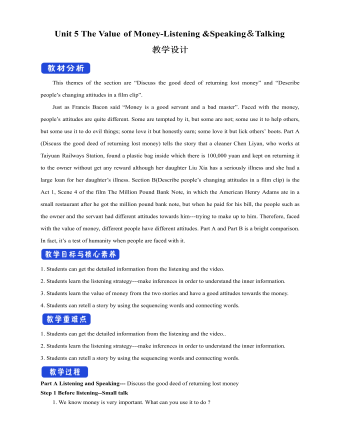
新人教版高中英语必修3Unit 5 The Value of Money-Listening &Speaking&Talking教学设计
4. A:We’d like to have someone to say a word at the beginning to welcome the group.B:↙Who?A:We thought that you or Dr.Johnson might do it.B用降调说Who,其意思是问,对方想让谁在开场时致欢迎词。Step 6 Pronunciation---Practice1. Listen to the short conversation and mark the intonation with ↗, ↙ or ↙, ↗. Then discuss with a partner what they intend to convey by using different intonation.Owner: You know what ?↗ It’s a million-pound bank note↙.Waiter 1: Really ?↗(question)Waiter 2: Really !↙(unbelievable and surprised)Waiter 3: Really ?!↙↗(first question then surprised)2. Listen to the conversations. Underline the parts that are stressed and mark the intonation. Then talk about the implied meanings of the responses with different intonations. Listen again and repeat.1) Henry: It’s a nice suit.Owner: Oh, it’s perfect!↙(The intonation means it is very suitable for Henry.)2) Henry: Well, that’s very kind of you.Owner: Kind, sir ?↗(what you said is not right) No, it’s kind of you. You must come whenever you want and have whatever you like. Just having you sit here is a great honour !!↙(welcome you to come again)3)Henry:Well, to be honest, I have none. Oliver:(happily) What luck!(excited) Brother↗, what luck!↙(It means “Didn’t you hear it?”)Henry: Well, it may seem lucky to you but not to me!↗(angry) If this is your idea of some kind of joke, I don’t think it’s very funny. Now if you’ll excuse me, I ought to be on my way.↙(If so, I would leave.)Roderick: Please don’t go↙...(hope Henry can wait for a moment)Part B Viewing and Talking---Describe people’s changing attitudes in a film clipStep 1 Before-listening---Tell the filmYou are going to watch part of the film The Million Pound Bank Note. Look at these photos and guess what happens in the film.
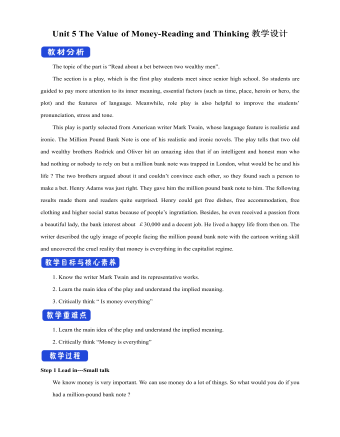
新人教版高中英语必修3Unit 5 The Value of Money-Reading and Thinking教学设计一
Everybody wants to get wealth.In today’s material world,making money or becoming wealthy symbolizes a person’s success and capability. Many people just make every effort, pay any price to attain greater wealth. With money,they can buy nice, large apartments in nice neighborhood. With money they can own luxurious cars. Wealth seems to bring all happiness in life.But is wealth the only road to happiness? Not really. There are many things in the world, which are beyond the means of money, such as friendship, love, health and knowledge. People are so preoccupied with struggling for money that they have no time or would not take the time to form or maintain friendship. What happiness can they feel living as lonely miserable creatures without love or friends in the world even if they accumulate tremendous wealth?In my opinion, people can’t do anything without money, but money is not everything. What money will bring you depends on your personal belief and goal in life. If you are kind enough to help others, especially the poor, money is a good thing to you. With it, you can do much more for the benefit of people and your country, and it will add to your own happiness. If you want money just for your own needs, you’ll never be satisfied or happy. In a word,you should have money spent for more people. Only then can money be the source of your happiness.Step 8 Homework4 students in a group, one acts Roderick, one Oliver, one servant and the fourth one acts Henry Adams, then listen to the tape, pay more attention to the difference between American English and British English in pronunciation, stress, tone.

新人教版高中英语必修3Unit 5 the value of money-Reading For Writing教学设计一
【参考范文】Narrator:(Henry is smiling as he leaves the restaurant. As he is walking down the street, he sees a sign for a place that cuts hair. He decides to get it cut. )H=Henry;B=Barber;R=rude manH:Good afternoon, I'd like to get a cut, if I may. (The barber looks at Henry's hair and continues cutting another man's hair. )Er, I'd really like a haircut. As you can see it's much too long. B:(in a rude manner) Yes, I can see that. Indeed, I can. H:Fine, well I'll have a seat then. (He sits in one of the barber's chairs. The barber turns to look at Henry. )B:It's quite expensive here, you know!Are you sure you can afford it?H:Yes. I think so. (In comes the rude man. )R:Hey you there. I need a haircut quickly. Can you do me straightaway?B:All right, then, get in the chair and I'll see what I can do. R:Thank you. (sits down in one of the barber's chairs)H:Excuse me, but I was here first. Aren't you going to do my hair first?B:This man's in a hurry. H:Well so am I!I insist that you cut my hair first. B:OK, but I'll have to be quick. This gentleman is waiting. H:Thank you. (They both become quiet. After his hair is cut, the barber tells Henry how much he must pay. Henry shows the barber the bank note. )B:Why, Mr . . . (looks shocked)H:Adams. Henry Adams. I'm sorry, I don't have any change. R:You're that Mr Adams! Well,I'm glad I waited or I might never have known it was you. B:Why, Mr Adams, please don't worry!(wearing a big smile) Nothing to worry about!Nothing at all!Please come back any time, even if you only need too little hairs cut!It will be my honour to serve you!

新人教版高中英语选修2Unit 4 Journey Across a Vast Land教学设计
当孩子们由父母陪同时,他们才被允许进入这个运动场。3.过去分词(短语)作状语时的几种特殊情况(1)过去分词(短语)在句中作时间、条件、原因、让步状语时,相当于对应的时间、条件、原因及让步状语从句。Seen from the top of the mountain (=When it is seen from the top of the mountain), the whole town looks more beautiful.从山顶上看,整个城市看起来更美了。Given ten more minutes (=If we are given ten more minutes), we will finish the work perfectly.如果多给十分钟,我们会完美地完成这项工作。Greatly touched by his words (=Because she was greatly touched by his words), she was full of tears.由于被他的话深深地感动,她满眼泪花。Warned of the storm (=Though they were warned of the storm), the farmers were still working on the farm.尽管被警告了风暴的到来,但农民们仍在农场干活。(2)过去分词(短语)在句中作伴随、方式等状语时,可改为句子的并列谓语或改为并列分句。The teacher came into the room, followed by two students (=and was followed by two students).后面跟着两个学生,老师走进了房间。He spent the whole afternoon, accompanied by his mom(=and was accompanied by his mom).他由母亲陪着度过了一整个下午。

新人教版高中英语选修2Unit 1 Science and Scientists-Learning about Language教学设计
Step 7: complete the discourse according to the grammar rules.Cholera used to be one of the most 1.__________ (fear) diseases in the world. In the early 19th century, _2_________ an outbreak of cholera hit Europe, millions of people died. But neither its cause, 3__________ its cure was understood. A British doctor, John Snow, wanted to solve the problem and he knew that cholera would not be controlled _4_________ its cause was found. In general, there were two contradictory theories 5 __________ explained how cholera spread. The first suggested that bad air caused the disease. The second was that cholera was caused by an _6_________(infect) from germs in food or water. John Snow thought that the second theory was correct but he needed proof. So when another outbreak of cholera hit London in 1854, he began to investigate. Later, with all the evidence he _7_________ (gather), John Snow was able to announce that the pump water carried cholera germs. Therefore, he had the handle of the pump _8_________ (remove) so that it couldn't be used. Through his intervention,the disease was stopped in its tracks. What is more, John Snow found that some companies sold water from the River Thames that __9__________________ (pollute) by raw waste. The people who drank this water were much more likely _10_________ (get) cholera than those who drank pure or boiled water. Through John Snow's efforts, the _11_________ (threaten) of cholera around the world saw a substantial increase. Keys: 1.feared 2.when 3. nor 4.unless 5.that/which 6.infection 7.had gathered 8.removed 9.was polluted 10.to get 11. threat

新人教版高中英语选修2Unit 1 Science and Scientists-Reading and thinking教学设计
Step 5: After learning the text, discuss with your peers about the following questions:1.John Snow believed Idea 2 was right. How did he finally prove it?2. Do you think John Snow would have solved this problem without the map?3. Cholera is a 19th century disease. What disease do you think is similar to cholera today?SARS and Covid-19 because they are both deadly and fatally infectious, have an unknown cause and need serious public health care to solve them urgently.keys:1. John Snow finally proved his idea because he found an outbreak that was clearly related to cholera, collected information and was able to tie cases outside the area to the polluted water.2. No. The map helped John Snow organize his ideas. He was able to identify those households that had had many deaths and check their water-drinking habits. He identified those houses that had had no deaths and surveyed their drinking habits. The evidence clearly pointed to the polluted water being the cause.3. SARS and Covid-19 because they are both deadly and fatally infectious, have an unknown cause and need serious public health care to solve them urgently.Step 6: Consolidate what you have learned by filling in the blanks:John Snow was a well-known _1___ in London in the _2__ century. He wanted to find the _3_____ of cholera in order to help people ___4_____ it. In 1854 when a cholera __5__ London, he began to gather information. He ___6__ on a map ___7___ all the dead people had lived and he found that many people who had ___8____ (drink) the dirty water from the __9____ died. So he decided that the polluted water ___10____ cholera. He suggested that the ___11__ of all water supplies should be _12______ and new methods of dealing with ____13___ water be found. Finally, “King Cholera” was __14_____.Keys: 1. doctor 2. 19th 3.cause 4.infected with 5.hit 6.marked 7.where 8.drunk 9.pump 10.carried 11.source 12.examined 13.polluted 14.defeatedHomework: Retell the text after class and preview its language points

新人教版高中英语选修2Unit 2 Bridging Cultures-Discovering useful structures教学设计
The grammar of this unit is designed to review noun clauses. Sentences that use nouns in a sentence are called noun clauses. Nominal clauses can act as subject, object, predicate, appositive and other components in compound sentences. According to the above-mentioned different grammatical functions, nominal clauses are divided into subject clause, object clause, predicate clause and appositive clause. In this unit, we will review the three kinds of nominal clauses. Appositive clauses are not required to be mastered in the optional compulsory stage, so they are not involved.1. Guide the students to judge the compound sentences and determine the composition of the clauses in the sentence.2. Instruct students to try to learn grammar by generalizing grammar rules, controlling written practice, and semi-open oral output.3. Inspire the students to systematize the function and usage of noun clause1.Instruct students to try to learn grammar by generalizing grammar rules, controlling written practice, and semi-open oral output.2.Inspire the students to systematize the function and usage of noun clauseStep1: The teacher ask studetns to find out more nominal clauses from the reading passage and udnerline the nominal clauses.

新人教版高中英语选修2Unit 3 Food and Culture-Discovering useful structures教学设计
The newspaper reported more than 100 people had been killed in the thunderstorm.报纸报道说有一百多人在暴风雨中丧生。(2)before、when、by the time、until、after、once等引导的时间状语从句的谓语是一般过去时,以及by、before后面接过去的时间时,主句动作发生在从句的动作或过去的时间之前且表示被动时,要用过去完成时的被动语态。By the time my brother was 10, he had been sent to Italy.我弟弟10岁前就已经被送到意大利了。Tons of rice had been produced by the end of last month. 到上月底已生产了好几吨大米。(3) It was the first/second/last ... time that ...句中that引导的定语从句中,主语与谓语构成被动关系时,要用过去完成时的被动语态。It was the first time that I had seen the night fact to face in one and a half years. 这是我一年半以来第一次亲眼目睹夜晚的景色。(4)在虚拟语气中,条件句表示与过去事实相反,且主语与谓语构成被动关系时,要用过去完成时的被动语态。If I had been instructed by him earlier, I would have finished the task.如果我早一点得到他的指示,我早就完成这项任务了。If I had hurried, I wouldn't have missed the train.如果我快点的话,我就不会误了火车。If you had been at the party, you would have met him. 如果你去了晚会,你就会见到他的。
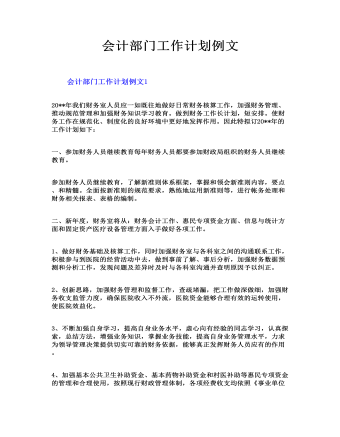
会计部门工作计划例文
1、做好财务基础及核算工作,同时加强财务室与各科室之间的沟通联系工作,积极参与到医院的经营活动中去,做到事前了解、事后分析,加强财务数据预测和分析工作,发现问题及差异时及时与各科室沟通并查明原因予以纠正。 2、创新思路,加强财务管理和监督工作,查疏堵漏,把工作做深做细,加强财务收支监管力度,确保医院收入不外流,医院资金能够合理有效的运转使用,使医院效益化。

财务部工作计划例文
一、加强会计核算工作。目前财务部会计核算是在初步实现会计电算化的基础上进行的,已基本建立电算化为主、手工账为辅,电算化手工账相互印证的 核算管理模式,较好的处理了手工核算中的计账不规范和大量重复劳动产生的错记、漏计、错算、重复等错误。下一步将继续加大财务基础工作建设,从票据粘贴、凭证装订、账证登录、报表出具等工作抓起,认真审核原始票据,细化账务处理流程,内控与内审结合,每月进行自查、自检,做到账目清楚,账证、账实、账表、账账相符,使财务基础工作更加规范化。为做好以上工作,要求全体财务人员在工作中认真学习,不断总结经验及教训,把财务核算工作做得更精细化,能够全面、细致、及时地为公司及相关部门提供翔实信息,并要从单一的会计核算向前端的财务筹划、过程中的财务监督、事后的财务分析转移,为公司领导层决策提供可靠依据。
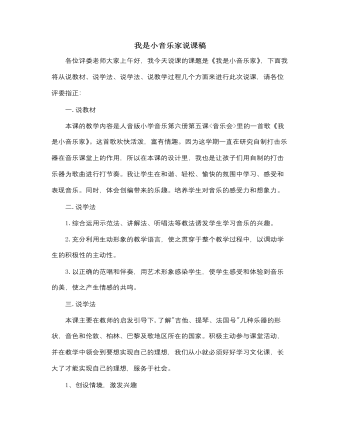
人音版小学音乐三年级下册我是小音乐家说课稿
都说教学是一门遗憾的艺术,在总结这堂课优点的同时我也清醒地认识到了自己的不足。比如在歌曲教学中,有不少节奏难点,如"0勃隆︱砰砰砰勃隆︱砰砰砰"中的八分休止符及十六分音符节奏的弱起衬词"勃隆",是比较难处理的,虽然通过反复的听唱,学生掌握得比较到位,但是我觉得是缺少解决方法的。课后我在思考,如果为了不让学生将"勃隆"两字常到强拍位置而让学生只唱"砰砰砰",将八反休止符及"勃隆"放在心里默唱,这样,更能确定"砰砰砰"的准确拍位,同时在默唱时也能聆听"勃隆"两字的弱起感觉。又比如在"跳?哟唱哟"这一字多音的乐句,处理最不好,尽管我进行了多次范唱,节奏仍有错误,学生还是很明显地将"跳?哟唱哟"唱成了"跳哟唱哟"。课后我思考在教学生唱"跳"字时做一个伸懒腰的动作,并在"531︱21︱"中的"3"音处加个"ao"音,节奏,那么难点解决了嘛!
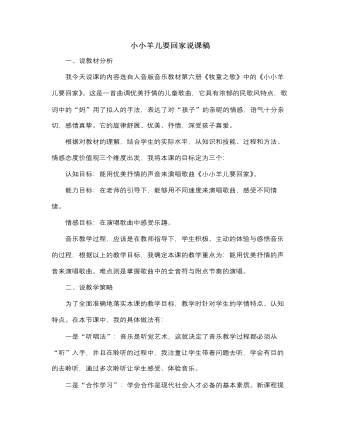
人音版小学音乐三年级下册小小羊儿要回家说课稿
(设计意图:给学生创设了一个愉快轻松的真情空间。这一环节给了学生大胆表达自己的感受,从各自不同的角度来感悟,培养了审美能力,使其积极性、自觉性、主动性得到了充分体现,活跃了课堂气氛,收到事半功倍的效果。至此,课堂推向高潮。最后,再次播放歌曲《小小羊儿要回家》,让孩子们把歌声带出教室,奔向属于他们的天地。五、教学说明各位老师、说话说:教学有法,但无定法,贵在得法。在本课教学设计中,我精心组织开放而有活力的课堂教学,尊重学生独特的情感与创造体验,始终贯穿“学生是学习和发展的主体”这一教育理念。采用多元化的教学手段,融音乐、表演为一体,发挥学生的创造能力,通过唱、听等丰富学生的情感体验,使学生的音乐审美素养得到全面提高,创设一个自由民主,宽松和谐,愉快互动的真情空间。突出学生活动、教师引导、共同探讨、总结求精的教学风格,使艺术课堂焕发勃勃生机。教学研究永无止境,我相信,没有最好,只有更好!
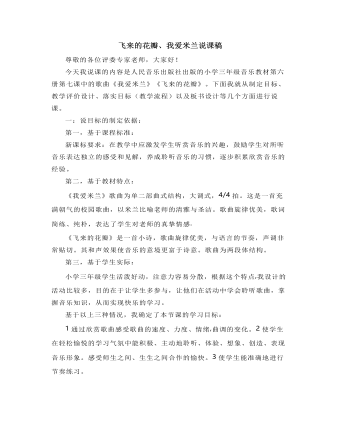
人音版小学音乐三年级下册飞来的花瓣、我爱米兰说课稿
1、运用橡皮筋听音乐学生讨论并回答。《我爱米兰》曲调跳荡《飞来的花瓣》曲调平稳2、运用学生自带的钥匙链等能发出声音的第二次欣赏《我爱米兰》《飞来的花瓣》老师引导学生分析乐曲节奏的不同《我爱米兰》节奏紧密《飞来的花瓣》节奏宽松6、运用身体动作第三次次欣赏《我爱米兰》《飞来的花瓣》老师引导学生分析乐曲速度的不同《我爱米兰》速度稍快《飞来的花瓣》速度中速7、运用彩色纸第四次欣赏《我爱米兰》《飞来的花瓣》老师引导学生分析乐曲情绪的不同《我爱米兰》情绪明快《飞来的花瓣》情绪深情(五)拓展延伸这一环节主要是让学生积累课外的音乐知识,拓宽学生的文化视野,提高学生的人文素养。最后,请大家用自己的话说说对歌曲的理解?师生在《长大后我就成了你》的歌曲声中结束本课。六:板书设计:层次分明。对比清晰谢谢大家!我的说课到此结束,敬请各位评委老师多多给予指导。
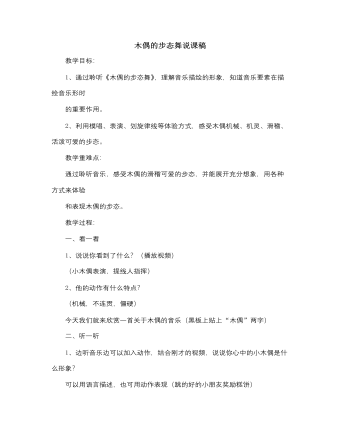
人音版小学音乐三年级下册木偶的步态舞说课稿
5、好,非常不错,请你上来把这个名字写下来吧。6、老师觉得这段音乐还缺点什么,于是我做了一些变化,来听听,这段音乐和之前比起来,都有哪些变化呢?(出示比一比课件)六、比一比1、(速度慢了,音高变低了,力度变弱了,乐器多了弦乐器,音乐多了B主题)2、小木偶心情怎么样了?别着急,我们再来听听(分别聆听①②片段)3、老师把这个主题称之为B主题,谁来给这个主题取一个生动的名字呢?4、小木偶很伤心,谁来说一句话鼓励鼓励他?5、小木偶听到你们的话了,接着来听听,小木偶心情又有什么变化?6、变得高兴起来了,又挑起了刚才的“快乐舞”(贴上A1主题,写上“快乐舞”)7、那现在我们完整的来聆听曲子吧,听到“快乐舞”时用舞蹈表示,听到“悲伤舞时坐下来划旋律线表示。
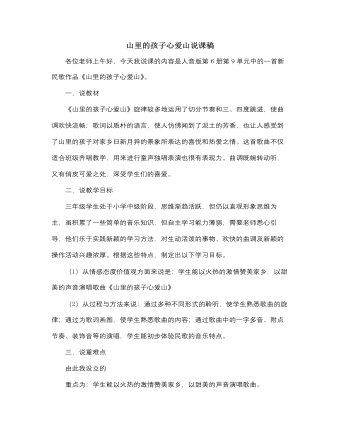
人音版小学音乐三年级下册山里的孩子心爱山说课稿
(1)喊:喂--喂;你好啊--你好啊;(2)唱:有旋律的,2468小节的旋律"喂喂喂""哗啦啦""叮咚叮咚"(3)这些都可能是山里的什么声音?师生讨论(4)师生接唱"大山的回声--喂喂喂;风吹树叶--哗啦啦;山里的泉水--叮咚叮咚;山里的歌声--多动听"连接话题:如果你到了山里,你最想做什么事情?那我们就去山里摘一摘果子吧!第二部分学唱部分1、播放伴奏音乐,师生一起根据音高,做摘果子和吃果子的律动2、再次播放伴奏,边哼唱边表演摘果子动作过渡句:自己摘的果子可真好吃啊,我们以拉歌的形式把山里的小伙伴也叫出来吧!3、第三遍播放伴奏,教师范唱前8小节4、熟悉歌词以画图的方式,将歌词展现出来山里的孩子心爱山,从小就生长在山路间,山里的泉水香喷喷,山里的果子,肥又甜,山里的孩子心爱山,山里有我的好家园,山上是我们村里的树,山下是我们村里的田。
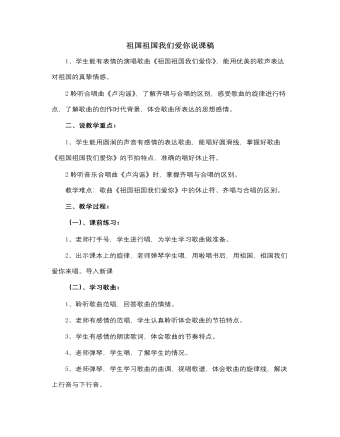
人音版小学音乐三年级下册祖国祖国我们爱你说课稿
5、加入二声部让学生进行演唱,注意声部间的和谐。6、学生分组表演并进行交换。告诉学生以上的两种演唱形式分别是齐唱与合唱。7、聆听《卢沟谣》:8、学生听音乐,歌曲分为几部分?歌曲表现的是什么内容?9、出示歌词,永定河、卢沟桥、宛平城是什么?简介卢沟桥事变。学生有感情的读歌词,10、听歌曲第一部分,体会歌曲的演唱形式,并进行学唱。11、听歌曲的第二部分,体会演唱形式,与第一段相比,情绪有什么变化?(合唱部分音区变高,节奏舒展,力度增强,情绪更激昂。)12、完整聆听歌曲,跟着哼唱。(三)、小结:听着这首歌曲,欣赏着这样的画面,你们是不是也知道珍惜今天的幸福生活来之不易呢?你是不是更爱我们的祖国呢?(放歌曲《祖国祖国我们爱你》结束本课)
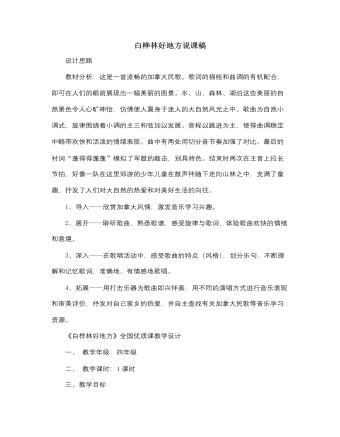
人音版小学音乐四年级下册白桦林好地方说课稿
3、想象歌词意境,自配动作,有表情地学唱歌曲。(1)引导学生为第一段每一句歌词配上动作,老师做适当提示(可为第一句歌词做示范)。(学生想象思考,并请个别学生作示范引导大家一起做),将第一段歌词连起来唱一遍,用动作加强音乐记忆和情感体验。(2)第二段歌词的学唱采用师生“接唱”,可老师唱前一句,学生后后一句,唱一遍,然后再交换。结尾句大家一起唱。(提示放慢速度,轻轻试唱。交换唱一遍)(3)第三段歌词学生自主学习。采用“接唱”的形式,男女生分组,或将学生分成两组,进行接唱,情绪豪迈的部分可引导男生唱,柔和抒情的部分女生唱,结尾句大家一起唱。(教师引导学生自己思考,自己处理)4、学生小结学习经验,提出演唱方案,并引导学生找出歌曲中的音乐符号f、mp、>、渐弱,在演唱时加以运用和注意表现。)最好将这些符号做成卡片!用力度变化的方法,演唱整首歌一遍,(可加动作、接唱等)
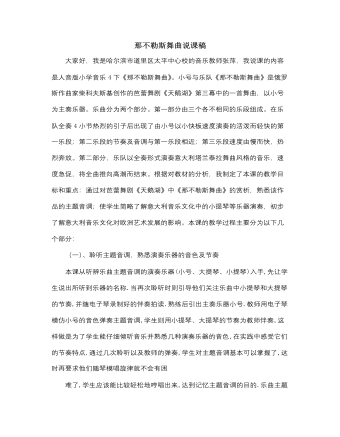
人音版小学音乐四年级下册那不勒斯舞曲说课稿
这种舞蹈就被称为塔兰泰拉舞。学生会根据这个小故事想象舞蹈应该有怎样的特点,动作剧烈、节奏急促、速度越来越快等等.这些特点让他们自己总结出来会比教师生硬的讲解更容易被接受(四)、再次聆听乐曲的第二部分,感受塔兰泰拉舞曲风格特点初步了解塔兰泰拉舞曲后再让他们聆听乐曲的第二部分,想象一下芭蕾舞演员随着这样的音乐会做怎样的动作.再完整欣赏这段《天鹅湖》第三幕中意大利女郎所跳的舞蹈视频,引导学生关注舞蹈动作的特点,加深对塔兰泰拉舞曲风格的感受.(五)、拓展延伸为了开阔学生的视野、对教材进一步拓展,完整欣赏后结合《天鹅湖》简介芭蕾舞的特征,并由它的起源引出意大利相关的音乐文化-----小提琴的制作工艺及价值等,使学生初步了解意大利音乐文化对欧洲艺术发展的影响。最后,在小提琴版《那不勒斯舞曲》的伴随下,幻灯播放意大利那不勒斯的美丽风光结束本课教学.

